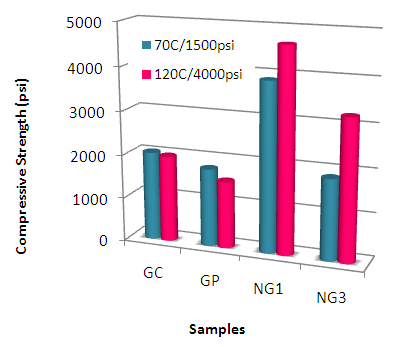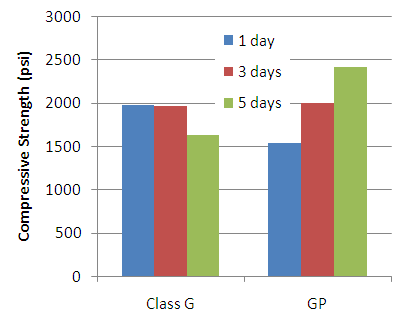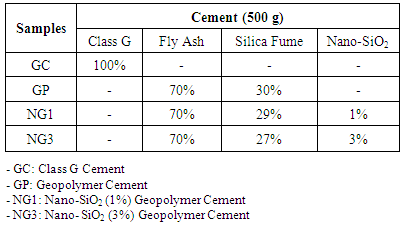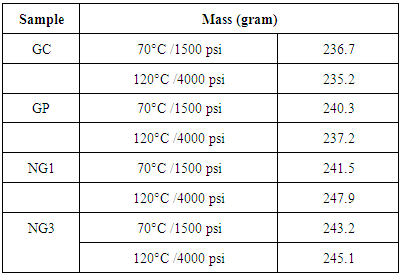-
Paper Information
- Next Paper
- Previous Paper
- Paper Submission
-
Journal Information
- About This Journal
- Editorial Board
- Current Issue
- Archive
- Author Guidelines
- Contact Us
Journal of Civil Engineering Research
p-ISSN: 2163-2316 e-ISSN: 2163-2340
2015; 5(4A): 6-10
doi:10.5923/c.jce.201501.02
The Strength Compatibility of Nano-SiO2 Geopolymer Cement for Oil Well under HPHT Conditions
Syahrir Ridha, Utami Yerikania
Department of Petroleum Engineering, Universiti Teknologi PETRONAS
Correspondence to: Syahrir Ridha, Department of Petroleum Engineering, Universiti Teknologi PETRONAS.
| Email: |  |
Copyright © 2015 Scientific & Academic Publishing. All Rights Reserved.
Besides having mechanical degradation under high pressure high temperature (HPHT) conditions, the use of Ordinary Portland Cement (OPC) may contribute the growth of global warming. Addressing this challenge, geopolymer cement which is also known as green cement has been introduced to be the alternative cement material in drilling operation. Nevertheless, the compatibility of geopolymer cement should meet the oil well cement requirement. In this study, geopolymer cement was admixed with nano-SiO2 and investigated under wellbore conditions which can affect its performance. The investigations encompassed the compressive strength using compressive strength tester and mass loss identification of nano-SiO2 geopolymer cement cured under HPHT. By means of the inclusion of nanomaterial in geopolymer, the nano-SiO2 geopolymer showed better endurance under high pressure and high temperature as compared to conventional OPC.
Keywords: Strength, Geopolymer Cement, Oilwell Cement, Nano-SiO2, HPHT
Cite this paper: Syahrir Ridha, Utami Yerikania, The Strength Compatibility of Nano-SiO2 Geopolymer Cement for Oil Well under HPHT Conditions, Journal of Civil Engineering Research, Vol. 5 No. 4A, 2015, pp. 6-10. doi: 10.5923/c.jce.201501.02.
Article Outline
1. Introduction
- Widely used cement in the oil industry is a type of Ordinary Portland Cement (OPC) in which the classes of oil well cements are classified according to the downhole temperature and pressure [1]. Oil well cement is considerably dissimilar to the cement used in construction industry in consequence of various wellbore conditions which may influence the cement performance especially in High Pressure High Temperature (HPHT). OPC has weaknesses associated with strength development in HPHT conditions. It may significantly reduce cement strength and durability which in turn cement integrity became failure. To overcome such challenges, the research on replacing Ordinary Portland Cement (OPC) with another cement materials is introduced. As the environmental regulation is more stringent from time to time, the request on using “greener” or more environment friendly material in oil and gas exploration is increasing. Raw materials of OPC, commercial cement material, are proven producing high emission of CO2 as one of major green house gases which is accounting for 82% of the total [2]. Improving the energy conversion efficiency of fossil fuels, shifting energy production to low carbon sources, enhancing uptake by terrestrial and marine biomass, and capturing and storing CO2 deep underground are such ways in reducing GHG emission of cementing process [3]. Environment reason reinforces the studies of the new green cement material as well. As a concern, a greener alternative inorganic polymer cement but having similar performance or exceed OPC is investigated to substitute the using of OPC named Geopolymer cement. Geopolymer is a low calcium, alkali activated aluminosilicate cement which has been gone through geopolymerization as chemical process in reacting aluminosilicates with aqeous alkaline solutions to produce a new class of inorganic binders. Test experiments proved that fly ash based geopolymer cement has excellent compressive strength and good acid resistance which have been indicated at atmospheric pressure and temperature [3]. Moreover, geopolymer is processed from waste materials which contribute the added values of this raw material.Despite the fact that geopolymer cement has some advantages stacked up to OPC, it is stated that geopolymer cement only possesses better performance than Class G cement in term of compressive strength at 36°C -80°C [3]. However, it must be noted that there is a possibility of breaking up inter granular structure of geopolymer at very high curing temperatures (>100°C) and hence it could lead to strength reduction. In consequences of this phenomenon, nanoscale particle is admixed to geopolymer cement as it is reliable in property enhancement. Hence, the strength reduction at high pressure and high temperature may be less than that of base geopolymer. This study specified how strong the nano-SiO2 geopolymer withstands the high pressure high temperature conditions where two curing conditions were applied in this experiment. This finding can contribute to the improvement in oil well cementing under high pressure high temperature conditions by securing its well’s integrity and durability.
2. Materials
2.1. Geopolymer Cement
- Sustainable cement has been developed in the response of environment and industry which is geopolymer. Geopolymer cement is low calcium, alkali activated aluminosilicate cement which has been gone through geopolymerization as chemical process in reacting aluminosilicates with aqeous alkaline solutions to produce a new class of inorganic binders. The low calcium fly ash in geopolymer is considered as a waste material which is somehow cheaper than the Portland cement. One tone of low calcium fly ash can be utilized to produce about 2.5 cubic meter of high quality geopolymer cement [4]. Some studies have indicated that geopolymer cement possesses higher strength, excellent acid resistant characteristics, very little shrinkage compared to OPC, no harm by alkali aggregate reaction (AAR) and has higher pumpability compared to OPC [5-6].The geopolymerization process involves three separate processes and during initial mixing, the alkaline solution dissolves silicon and aluminium ions in the raw material (fly ash, slag, silica fume, bentonite, etc.) [6]. In this research, the mixture of fly ash and silica fume will act as the base of geopolymer with the composition of 70:30 respectively.
2.2. Nanotechnology
- Recently, the application of nanomaterials to solve problems in oilwell cementing has begun to be investigated by several different research groups in the oil and gas industry [7-8]. Nanoengineering of cement-based materials can result in outstanding or smart properties. Introduction of nanotechnology in cement industry has the potential to address some of the challenges such as CO2 emissions, poor crack resistance, long curing time, low tensile strength, high water absorption, low ductility and many other mechanical performances. A remarkable improvement in the mechanical properties and durability of cementitious materials can be observed with incorporation of nanomaterials such as nano-SiO2, ZnO2, Al2O3, TiO2, carbon nanotubes, nano-clays, carbon nanofibers and other nanomaterials [9-10]. Among those types of nanomaterials, this study utilized nano-SiO2 as it enhanced mechanical properties (compressive strength), lower porosity and permeability, increased durability and crack resistance [11]. The amounts of admixed nano-SiO2 in two geopolymer cement samples are 1% and 3%.
2.3. Class G Cement
- In this study, Portland Class G cement is selected as the base line cement to specify the performance of nano-SiO2 geopolymer in set wellbore conditions. Class G cement is conventional and commercial cement material and made from raw materials such as clay and limestone [11]. Class G cement is applicable as basic oil well cement from surface of earth to the depth of 8000 ft (2440 m) [12].
3. Experimental Procedures
- There were three stages of procedures in this experiment. It involved preparation of cement cube samples, determination of compressive strength and mass loss identifications of cement cubes. The first procedure of experiment was the preparation of cement cubes according to American Petroleum Institute API-10A [13]. It was mixed in a constant speed mixer at 4,000 rpm for 30 minutes and the mixing speed was increased to 12,000 rpm and the mixing process was continued for another 35 minutes. During the first 30 minutes, cement powder was poured gently into the mixer that had been filled with water until it was well mixed; then the mixing was continued for 35 minutes longer. Detail compositions of cement sample are shown in Table 1.
|
 | (1) |
4. Results and Discussions
- The compatibility was identified through the mechanical properties of the cement samples. These mechanical properties were including the compressive strength and mass loss determination.
4.1. Compressive Strength
- The result of compressive strength for samples under 70°C and 1500 psi is shown in Table 2.
|
 | Figure 1. Compressive Strength of Cement Samples at Two Curing Conditions for 24 hours Hydration Time |
 | Figure 2. Compressive Strength of Cement Samples at 120oC/4000 psi against Three Hydration Times |
4.2. Mass Loss
- The mass loss of cement in this study represents the solubility of cement at HPHT condition. The result of mass changes is presented in Table 3. The changes of mass of cement samples were most likely similar to the alteration of strength values. Both GC and GP went through degradation of mass for 0.6% and 1.2 %, respectively. It is due to HPHT conditions led the breaking up of inter granular structures of GC and GP which left empty spaces and caused the reducing of mass. Contrast to GC and GP, the mass of nano-SiO2 geopolymer cement samples escalated by 2.6% for NG1 and 0.7% for NG3. This is primarily because of nano-SiO2 of NG1 and NG3 favourably aided to fill empty spaces of geopolymer cement which gained the mass and strength of samples.
|
5. Conclusions
- The study found that NG1 (geopolymer cement with 1% nano-SiO2) possessed highest strength value at both curing temperatures and pressures (70°C/1500psi and 120°C/4000psi). NG3, which contained 3% nano-SiO2, also increased the strength of geopolymer cement but not as much as NG1 which is probably because of the contents of nano-SiO2 in NG3 exceed the optimal amount of nano-SiO2 used for enhancing mechanical property of cement samples. It must be noted that at HPHT, both NG1 and NG3 possessed the increasing value of strength which differed to Class G and pure geopolymer cement that encountered strength degradation. The results of mass loss were in line with compressive strength which NG1 and NG3 escalated by the mass values at HPHT condition. This research can be added knowledge to improve our understanding of geopolymer cement for possible use as well cement in various wellbore conditions.
ACKNOWLEDGEMENTS
- The authors express their gratitude for UTP financial assistance on this project under STIRF No. 0153AA-C48.
 Abstract
Abstract Reference
Reference Full-Text PDF
Full-Text PDF Full-text HTML
Full-text HTML

